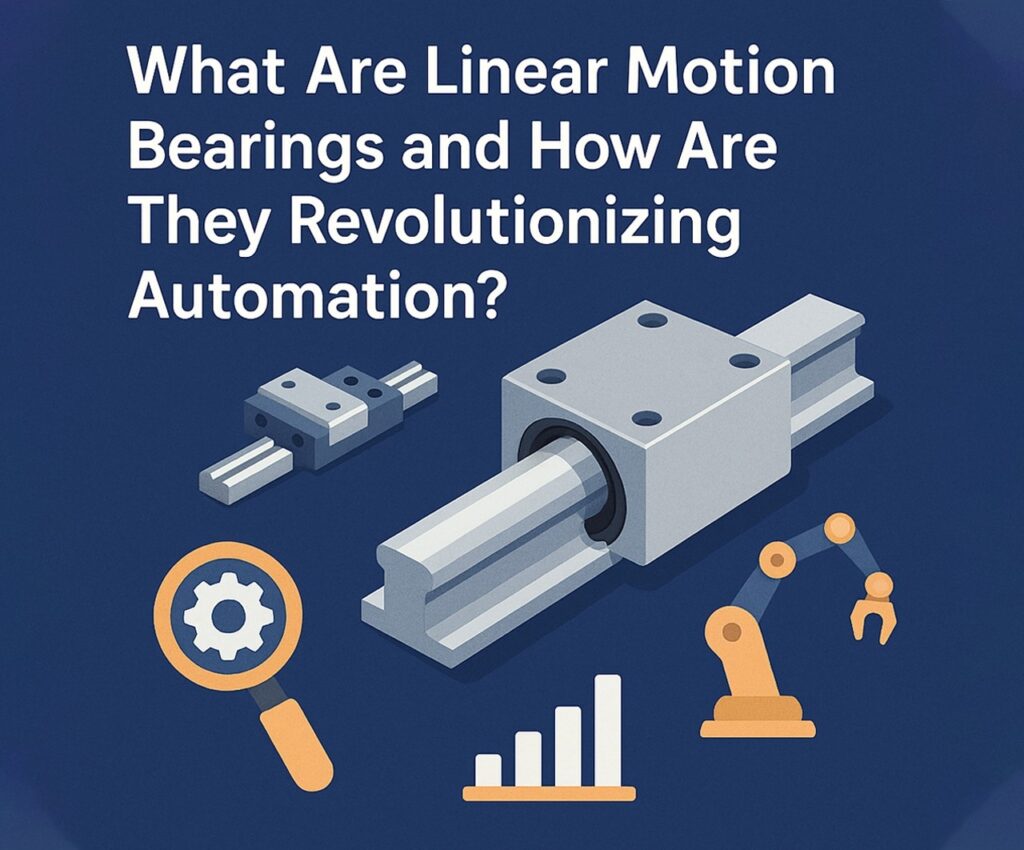In today’s fast-evolving industrial landscape, linear motion bearings, linear bearings, and linear slides are no longer just support components—they are foundational to automation’s rise. Whether you’re building CNC machines, robotics, packaging lines, or 3D printers, these technologies enable precise, frictionless motion that drives efficiency and accuracy. Their impact is quietly powerful, transforming how automation systems function across industries. Know More
What Are Linear Motion Bearings?
Linear motion bearings are mechanical components that allow movement along a straight path. Unlike traditional rotary bearings that revolve around an axis, linear bearings are designed to guide components back and forth along a linear axis with minimal friction. They pair with linear slides to form complete motion systems capable of high-speed, high-accuracy movements.
There are several types of linear motion bearings, including:
- Ball bushings: Cylindrical bearings using recirculating balls.
- Roller bearings: Use cylindrical rollers to handle heavier loads.
- Air bearings: Use a thin layer of pressurized air for ultra-low friction.
- Magnetic bearings: Levitated motion systems that eliminate contact entirely.
Each of these plays a unique role depending on load, speed, environment, and precision needs.
Why They Matter in Automation
Automation thrives on repeatability, speed, and efficiency. Linear motion bearings, especially when used with linear slides, reduce friction and wear, which means machinery lasts longer and runs smoother. With linear bearings, robots achieve micron-level accuracy, CNC machines maintain consistent tolerances, and automated inspection systems scan flawlessly.
As manufacturing demands tighter tolerances and faster throughput, the value of these components skyrockets. Think of them as the circulatory system for automated motion—invisible when functioning properly but catastrophic when they fail.
Creative Applications in Modern Industries
Let’s look beyond the basics. Here are some fresh, impactful ways linear motion bearings are changing the automation game:
1. Collaborative Robots (Cobots)
Cobots work alongside humans, often requiring lightweight, responsive mechanics. Linear bearings allow cobots to glide with minimal effort, supporting safety systems that stop motion upon contact.
2. Vertical Farming
Indoor agriculture uses stacked trays and robotic arms on linear slides to move produce, apply nutrients, and harvest with precision. Linear motion bearings in these systems help maintain accuracy in high-moisture, corrosion-prone environments.
3. Automated Optical Inspection (AOI)
In electronics manufacturing, AOI systems use linear slides and linear bearings to move cameras at high speeds with micrometer precision. Without smooth motion, image clarity suffers and defects go unnoticed.
4. 3D Printing and Additive Manufacturing
Consistency in print layers depends heavily on precise movements of print heads. Linear motion bearings ensure the head moves exactly where it should—layer after layer—to build complex parts with zero drift.
The Science Behind Smooth Motion
What makes linear motion bearings so effective is their ability to convert mechanical energy into guided movement with minimal resistance. Using either rolling elements or air films, they replace metal-on-metal friction with smooth, efficient travel. Here’s why this matters:
- Reduces heat and energy loss
- Extends component life
- Improves positioning accuracy
- Enables faster cycle times
Pair these with intelligent controls, and you get smart automation systems that adapt motion dynamically, increasing flexibility in production lines.
How to Choose the Right Linear Motion Bearing
Not all linear bearings are created equal. Choosing the right one depends on:
- Load type: Axial, radial, or combined.
- Speed requirements: High-speed systems need low-friction, lightweight setups.
- Environmental factors: Temperature, humidity, dust.
- Precision level: Medical and semiconductor applications demand ultra-tight tolerances.
Some advanced systems even integrate linear slides with feedback sensors to monitor movement in real time. This adds a layer of smart diagnostics and preventive maintenance.
Future Trends: Smarter, Smaller, Stronger
The evolution of linear motion bearings isn’t slowing down. Here’s what we can expect:
1. Miniaturization
As industries like wearables, biotech, and micro-robotics grow, linear bearings are being designed smaller without losing performance. These micro-bearings open doors to innovations in medical diagnostics and precision tools.
2. Embedded AI and IoT
Smart linear slides with embedded sensors now collect data on temperature, load, and wear. Combined with AI, systems can predict failures, optimize performance, and reduce downtime.
3. Sustainable Materials
Manufacturers are shifting to recyclable or biodegradable components for linear motion bearings, helping reduce carbon footprints while maintaining performance.
4. Magnetically Levitated Bearings
Still niche but growing, these systems offer frictionless motion that could redefine high-speed automation, especially in cleanrooms and vacuum environments.
Real-World Case Study: Electronics Assembly
A major consumer electronics company upgraded its assembly lines by integrating high-precision linear bearings and linear slides into their robotic arms. The result?
- 40% increase in production speed
- 30% decrease in maintenance costs
- 25% improvement in product consistency
This is a prime example of how relatively small components like linear motion bearings can make a massive impact when thoughtfully integrated.
Common Pitfalls and How to Avoid Them
To get the most out of your linear motion bearings, avoid these common mistakes:
- Underestimating load requirements: Leads to premature failure.
- Ignoring alignment: Poor mounting can cause misalignment and friction.
- Over-lubrication or wrong lubrication: Can attract debris or reduce performance.
- Skipping preventive maintenance: Even the best linear slides need occasional attention.
A small error in design or installation can multiply across production runs, so precision matters.
Final Thoughts: The Silent Revolution
Linear motion bearings, linear bearings, and linear slides might not make headlines, but they are behind every precise movement in the modern automated world. As technology advances, their role only becomes more critical. The next generation of smart factories, surgical robots, and inspection drones will rely on ever-more refined motion control—powered by these quiet but mighty components.
If you’re engineering automation systems, don’t underestimate the importance of selecting the right linear motion bearings. It’s not just about motion—it’s about making motion smarter, faster, and more efficient.
Ready to upgrade your automation setup? Start with the foundation. Explore high-performance linear bearings, precision-crafted linear slides, and next-gen linear motion bearings that are reshaping the future of motion control.

